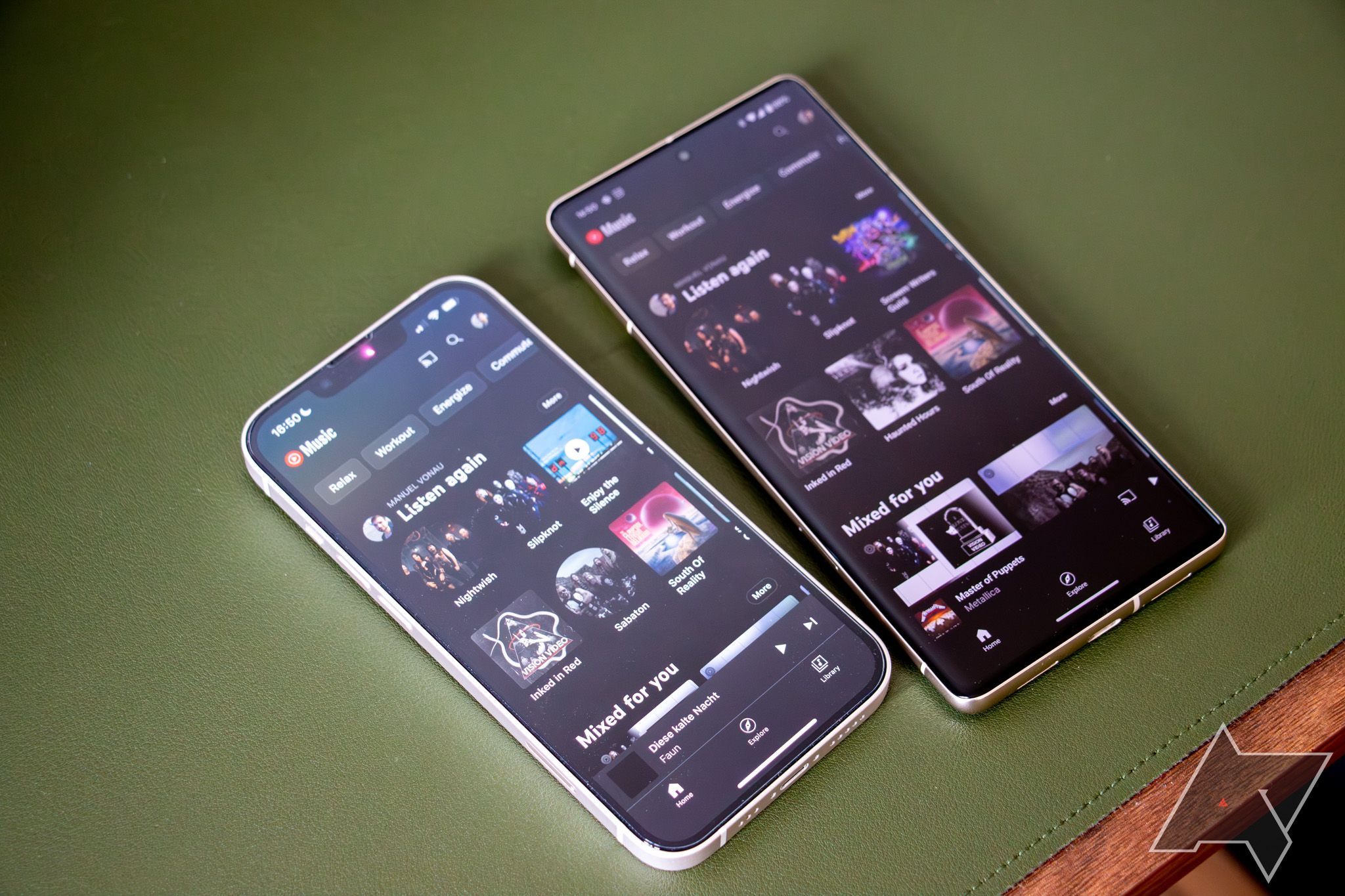iPhone apps are still more polished than Android apps, and I hate it
Android app design has come a long way since the gaudy Holo days, the look introduced back in 2011 with Android 4.0 Ice Cream Sandwich. Google deserves credit for taking design seriously across its mobile platform, and many third-party app developers have jumped in to build on top of what Google is offering with Material Design and Material You. But for as far as we’ve come on the latest and greatest phones, there is still a lot to do — particularly in the animation department.
ANDROID POLICE VIDEO OF THE DAY SCROLL TO CONTINUE WITH CONTENT
Personally, I always felt that Android has an edge over iOS when it comes to app design. Whether it’s the bad old #holoyolo days of Android 4, or the wonderful new world of Material Design we got with Android 5, Android apps have always seemed more approachable and less complicated to me than Apple’s skeuomorphism, or the super simplified look the company's been refining ever since the controversial changes of iOS 7.
But there is one area where I’ve always envied the experience of those firmly enmeshed in the Apple ecosystem: app animations and transitions. For years now, premium apps have not only usually come to iOS first, but many of them have also been developed as iOS-first products. The most maddening part of this is that I'm even jealous of Google apps, many of which feel more fluid on iOS, with more thoughtful animations and transitions than what you can find on Android.
The one reason why I like to pick up my iPhone from time to time
As much as I prefer Android as an operating system, there is a reason why I keep coming back to my iPhone, making it my daily carry phone from time to time — well, other than my wish to stay informed about what’s happening on the other big mobile operating system besides Android. Using an iPhone just feels like a more fluid, full experience than even a Google Pixel, which arguably offers Google’s grand vision of how Android should look and behave, including its first-party Google apps.
To a significant extent, the reason for this is animations and general app polish. This has been the case for years, and there's no shortage of examples showing just how much nicer things look and feel on an iPhone. But the app that recently really made this difference between platforms clear to me is Netflix. The service redesigned its iOS app a while back, giving it one of the smoothest and most fluid in-app navigation systems I’ve ever seen. Using Netflix on my iPhone is an unqualified joy, with fluid animations between each screen making the dreaded “what should we watch?” experience almost fun. The app reacts naturally to your input as you swipe through carousels and dismiss individual titles.
With that heightened sense for animations, it doesn't take long to start noticing just how many other apps are sprinkled with similar delightful navigation animations. One of my banking apps joyfully reveals a full view of a debit card when you swipe up. Google Maps builds its routes on the fly, giving you a sense of motion. WhatsApp delivers proper transitions when you open the keyboard or swipe to go back to all chats. And YouTube offers a rich, prolonged animation when you move your phone to landscape mode.
It's not that animations don't exist on Android apps at all. In fact, Android apps are also filled to the brim with all kinds of transitions and animations. What it boils down to is how well these animations are integrated with the actual movements of your fingers on the screen. When you transition from screen to screen and section to section on iOS, you get the sense that you're physically interacting with the interface and the interior workings of the phone, while there is always some semblance of disconnect on Android.
You could dismiss these animations as tacky, and yes, sometimes they're a little over the top. But they're all part of making the experience of tapping a cold glass screen with no tactile feedback slightly more delightful, creating a deeper bond between the actions you take and the reactions of the elements you see on the screen. It's no wonder that people like to stick with their iPhones when all they experienced on Android was a low-power 2012 phone that didn't have the oomph to provide delightful experiences like the iPhone was already capable of at the time.
Where is this divide coming from?
This gap between iOS and Android has existed almost from the beginning, and there are a few reasons for that. iOS has been around for longer than Android, and while it may have a smaller user base than Android on an international scale, iPhones are the smartphone to have in many cultures, and elicit a more premium vibe than Android phones. This means that many developers pay more attention to their apps on iOS, as they need to be more polished to fit in with the rest of the premium-feeling experience.
The reason is also rooted in the different approaches that Android and iOS have to system navigation. On iOS, gesture navigation has been the default and only option since the iPhone X, so gestures and fluid animations are already part of the normal experience on iOS — and developers have to acknowledge that. Due to the lack of a universal back gesture, app developers also have to use gestures and animations to guide users through their interfaces. This also gives developers full control over how their app behaves when someone navigates within it, while Android always offers multiple ways to navigate back, be it via a back button, a back gesture, or a custom implementation from a device manufacturer. This uncertainty makes it harder for developers to predict how their apps need to react to certain user input.
Imagine a world where Android would be limited to Pixel phones and how much better apps could be optimized for specific hardware
On top of this, Apple generally makes it easier for developers to add animations. The operating system is built for only a few different screen sizes, form factors, and processors, making it much easier to predict how well apps will run on devices, and how well they can handle animations. In contrast to that, Android runs on hundreds, if not thousands of different devices, form factors, screen sizes, and OS versions, making it harder for developers to rely on more modern libraries that might make it easier to animate apps, at least as long as they want to ensure backwards compatibility.
That's not to say that Apple's approach is necessarily better, particularly when you like your apps to reliably refresh in the background or an easy and intuitive way to navigate back, but it does offer advantages in the app design department.
Android 14 could save the day, but there is still a long road ahead
Android 14 could deliver a radical improvement in the animation department, and that's thanks to Android's system-wide and reliable back navigation system. Instead of putting the work on individual app developers and their animation and design skills, Google will make it possible for apps to opt into predictive back navigation. This will allow you to take a peek of the screen you’re about to navigate back to next, and you can already see this in action on some apps in Android 14 Beta 2. You do need to enable the predictive back gesture flag in the developer options, though.
If app developers so choose, they'll be able to add their own custom back navigation animations, too. Depending on which transitions make more sense, this could create a more unified, yet still individual experience across different Android apps. The only issue with this system is that it only works on an opt-in basis, so it might take a long time until all Android apps support it.
2 Images
Close
iOS back gestures (left); Android's new predictive back gestures (right)
Other parts of Android have already moved in this direction, especially on Pixel phones. This begins with small and long-standing parts of the UX. like when you swipe down to reveal the notification shade, the gestures you use to get back to the home screen, and the Pixel Launcher's sweet swipe-up animation to reveal both the app drawer and the keyboard. The Android system UI sans back gestures is almost on par with what Apple offers. The disconnect mostly exists within apps and especially when you use back gestures.
I'm very much looking forward to the future, once all or even just many apps get on board with Google's redesigned back gestures. Even if most developers only rely on the default transition provided by the OS, this should already lead to a much more fluid and consistent experience.
Source: Android Police


